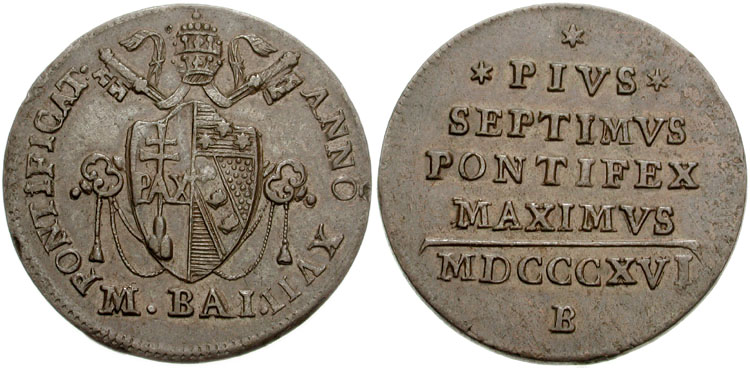- Papal States scudo
Coin image box 1 double
header =Sede vacante
hbkg = #abcdef
_651183.jpg)
caption_left = SEDE VACANTE MDCCCXXXXVI, cardinal Riario-Sforza coat-of-arms surmounted bycanopy , crossed keys, and cardinal's cap; R (mint) and NIC C (Niccolò Cerbara , engraver) inexergue
caption_right = NON RELINQVAM VOS ORPHANOS, SCUDO in exergue, radiatedove flying facing, head right.
width = 250
footer = AR Scudo (26.98 g). Dated 1846.
position = right
margin = 0The scudo (plural: "scudi") was the currency of thePapal States until 1866. It was divided into 100 "baiocchi" (singular "baiocco"), each of 5 "quattrini". Other denominations included the "grosso" of 5 baiocchi, the "carlino" of 7½ baiocchi, the "giulio" and "paoli" both of 10 baiocchi, the "testone" of 30 baiocchi and the "doppia" of 3 scudi.History
In addition to issues for the Papal States as a whole, the currency was also issued by many of the individual states. In the late 18th century, this included issues from
Ancona , Ascoli,Bologna ,Civitavecchia ,Fano ,Fermo ,Foligno ,Gubbio ,Macerata ,Matelica , Montalto, Pergola,Perugia ,Ronciglione , San Severino,Spoleto ,Terni , Tivoli andViterbo . Uniquely, in Bologna, the baiocco (also known as the "bolognino") was subdivided into 6 quattrini.Between 1798 and 1799, the revolutionary French forces established the Roman Republic, which issued coins denominated in baiocco and scudo. In addition, the states of Ancona, Civitavecchia, Clitunno, Foligno, Gubbio, Pergola and Perugia issued coins in the name of the Roman Republic.
In 1808, the Papal States were annexed by France, and the
French franc circulated officially. When the Pope's authority was restored in 1814, the scudo was restored as the currency. However, the coinage of the individual states was not resumed. In 1849, another Roman Republic was established which issued coins centrally and in Ancona.In 1866, the scudo was replaced by the lira, equivalent to the
Italian lira . The exchange rate used was 5.375 lire = 1 scudo. [ [http://www.tesionline.it/__PDF/9525/9525p.pdf] it_icon]Coins
Coin image box 1 double
header =Pius VII (1800 - 1823)
hbkg = #abcdef

caption_left = Papal coat-of-arms. around PONTIFICAT. ANNO XVII. In exergue M. BAI.
caption_right = Legend PIVS / SEPTIMVS / PONTIFEX / MAXIMVS. Date: MDCCCXVI (1816) and mintmark. (B)
width = 300
footer = Æ Half Baiocco (27mm, 5.80 g). Bologna mint. Dated RY 17, AD 1816.
position = right
margin = 0Coin image box 1 double
header = Roman Republic (1849)
hbkg = #abcdef

caption_left = Eagle onfasces . DIO E POPOLO. Mint mark (R)
caption_right = Value. REPUBBLICA ROMANA Date: 1849
width = 300
footer = Æ 3 baiocchi. Rome mint
position = right
margin = 0In the late eighteenth century, coins were issued in copper in denominations of 1 quattrino, ½, 1, 2, 2½ and 5 baiocchi, along with billon coins for 1, 4, 8, 12, 25 and 50 baiocchi, 1 and 2 carlini, silver coins for 1 grosso, 1 and 2 guilio, 1 testone and 1 scudo, and gold coins for ½ and 1 "zecchino" and 1 and 2 doppia. The individual states issued similar coinages, with the exception of Bologna, which additionally issued silver 12 baiocchi, ½ scudo and 80 bolognini, and gold 2, 5 and 10 zecchini. The 1798 to 1799 Roman Republic issued copper ½, 1, 2 and 5 baiocchi and silver 1 scudo.After the restoration of the currency, billon coins were no longer issued and several other denominations disappeared. There were copper 1 quattrino, ½ and 1 baiocco, silver 1 grosso, 1 and 2 guilio and 1 scudo, and gold 1 doppia. The silver testone was reintroduced in 1830, followed by 50 baiocchi in 1832.
In 1835, a new coinage was introduced which abandoned all the denomination names except for the quattrino, baiocco and scudo. Copper coins were issued in denominations of 1 quattrino, ½ and 1 baiocco, with silver 5, 10, 20, 30 and 50 baiocchi and 1 scudo, and gold 2½, 5 and 10 scudi. In 1849, the Roman Republic issued a coinage consisting of copper ½, 1 and 3 baiocchi and silver 4, 8, 16 and 40 baiocchi. Following the restoration of the Papal States, copper 2 and 5 baiocchi were introduced.
Banknotes
From 1785, paper money was issued by the "S. Monte Della Pieta' di Roma" in denominations from 3 scudi up to 1500 scudi, whilst, from 1786, the "Banco di S. Spirito di Roma" issued notes from 3 scudi up to 3000 scudi. The 1798 to 1799 Roman Republic issued notes in various denominations including 3 and 40 baiocchi, 8, 9 and 10 paoli. The treasury of the Papal States issued notes during the 19th century.
ee also
Papal mint References
*numis cite SCWC|date=1979
External links
Standard numismatics external links
world_coin_gallery_1_url = Vatican
world_coin_gallery_1_name = Papal States
world_coin_gallery_1_anchor = Papal
banknote_world_1_url = Papal_States
banknote_world_1_name = Papal States
dollarization_1_url =
dollarization_1_name =
gfd_1_url = Vatican
gfd_1_name = Papal States
gfd_data_1_url =
gfd_data_1_name =
show_gfd_excel = Y
* [http://it.geocities.com/mp_pollett/monpap.htm Rome's old coinage]
Wikimedia Foundation. 2010.
